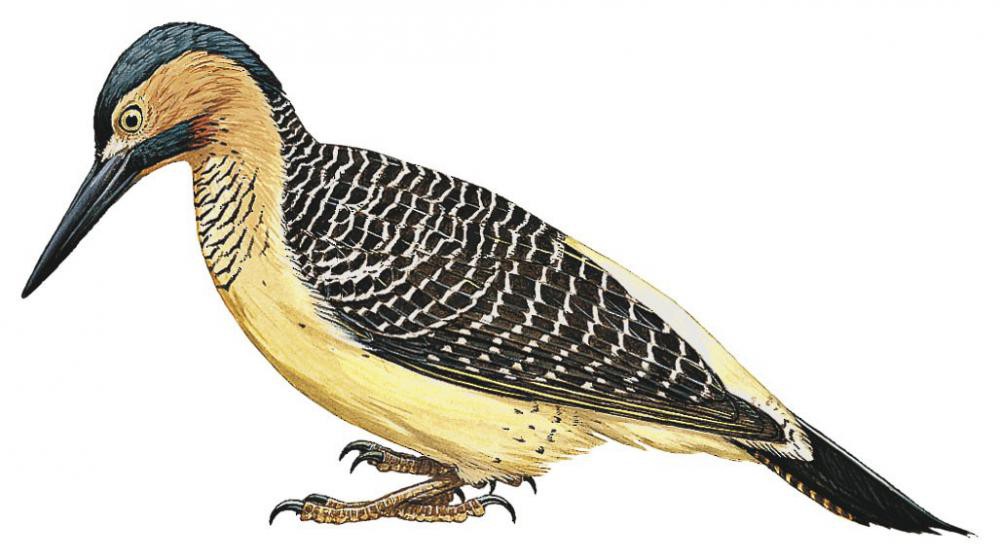Andean Flicker / Colaptes rupicola

Andean Flicker
SCI Name:
Protonym: Colaptes rupicola Voy.Am.merid. 4 livr.51 pl.62 fig.1
Taxonomy: Piciformes / Picidae / Colaptes
Taxonomy Code: andfli1
Type Locality: La Paz, Chuquisaca, Cochabamba and Potosi, Bolivia; type from Sicasica, fide Menegaux, Bull. Soc. Philom. Paris (10), 1, 1909, p. 207-208.)
Author: d'Orbigny
Publish Year: 1840
IUCN Status:
DEFINITIONS
COLAPTES
(Picidae; Ϯ Yellow-shafted Flicker C. auratus) Gr. κολαπτης kolaptēs chiseller < κολαπτω kolaptō to chisel, to peck, to strike; "The former group, or the Linnean Pici, it may be again observed, include some species where the bill loses the straight and angulated form, and becomes curved and compressed. These birds, of which the Picus auratus of Linnæus is the representative §, exhibit in this particular an evident approximation to the true Creepers ... § This group forms the genus Colaptes of Mr. Swainson." (Vigors 1825); "Colaptes Vigors, Trans. Linn. Soc. London, 14, pt. 3, 1826, p. 457, note. Type, by original designation, Cuculus auratus Linné." (Peters, 1948, VI, p. 100).
Synon. Chrysopicus, Chrysoptilus, Craugus, Geopicos, Malherbipicus, Nesoceleus, Pediopipo, Pituipicus, Soroplex, Theiopicus, Tridactylocolaptes.
RUPICOLA
(Cotingidae; Ϯ Guianan Cock-of-the-Rock R. rupicola) Mod. L. rupicola cliff-dweller < L. rupes, rupis rock < rumpere to shatter; -cola dweller < colere to inhabit. The Guianan Cock-of-the-rock was named “Coq-de-roche” because of its flat-sided, galliform crest and habit of nesting in caves; "Genus Rupicolæ. (1). ... (1) Nomen a me illi inditum ob habitationem in rupibus. ... Les François de la Guiane l'appellent COC DES ROCHES" (Brisson 1760): based on "Gallus ferus, saxatilis, croceus, cristam e plumis constructam gerens" of Barrère 1741, "Upupa Americana, crocea, saxatilis" of Barrère 1745, and "Upupa crocea" of Linnaeus 1748; "Rupicola Brisson, 1760, Ornithologie, 4, p. 437. Type, by monotypy, "Rupicola" = Pipra rupicola Linnaeus." (Snow in Peters 1979, VIII, 306).
Synon. Orinus.
● (syn. Columba Ϯ Rock Dove C. livia) "I rod'. Columba L. A) Rupicola. 1. Columba livia Briss. (C. neglecta Sewerzow). ... 2. Columba rupestris Pall. B) Sylvicola. 3. Columba fusca Pall. (C. Eversmanni Bp. = C. fusca, β brachyura Sew.). 4. Columba œnas Briss." (Bogdanov 1881) (OD per Laurent Raty); "Rupicola BOGDANOW, Trudy S.-Peterb. obshch. estest. (Zool.), vol. 12, 1881, p. 99. Type, Columba livia "BRISSON" (Present designation.)" (Richmond 1917).
rupicola
Mod. L. rupicolus cliff-dwelling < L. rupes, rupis rock < rumpere to shatter; -cola dweller < colere to inhabit.
● ex “Rocar” of Levaillant 1802, pl. 101 < French roc or rocher rock (syn. Monticola rupestris).
● ex “Traquet Montagnard” of Levaillant 1806, pl. 184, fig. 2 < French montagnard mountain-dweller (syn. Oenanthe monticola).
● ex “Gallus ferus saxatilis” of Barrère 1741, “Rupicola” of Brisson 1760, and “Hoopoe Hen” of Edwards 1764 (Rupicola).
SUBSPECIES
Andean Flicker (Northern)
SCI Name: Colaptes rupicola cinereicapillus
cinereicapilla / cinereicapillus
L. cinereus ash-grey < cinis, cineris ashes; -capillus -crowned < capillus hair of the head.
Andean Flicker (Southern)
SCI Name: Colaptes rupicola rupicola/puna
COLAPTES
(Picidae; Ϯ Yellow-shafted Flicker C. auratus) Gr. κολαπτης kolaptēs chiseller < κολαπτω kolaptō to chisel, to peck, to strike; "The former group, or the Linnean Pici, it may be again observed, include some species where the bill loses the straight and angulated form, and becomes curved and compressed. These birds, of which the Picus auratus of Linnæus is the representative §, exhibit in this particular an evident approximation to the true Creepers ... § This group forms the genus Colaptes of Mr. Swainson." (Vigors 1825); "Colaptes Vigors, Trans. Linn. Soc. London, 14, pt. 3, 1826, p. 457, note. Type, by original designation, Cuculus auratus Linné." (Peters, 1948, VI, p. 100).
Synon. Chrysopicus, Chrysoptilus, Craugus, Geopicos, Malherbipicus, Nesoceleus, Pediopipo, Pituipicus, Soroplex, Theiopicus, Tridactylocolaptes.
UPPERCASE: current genus
Uppercase first letter: generic synonym
● and ● See: generic homonyms
lowercase: species and subspecies
●: early names, variants, mispellings
‡: extinct
†: type species
Gr.: ancient Greek
L.: Latin
<: derived from
syn: synonym of
/: separates historical and modern geographic names
ex: based on
TL: type locality
OD: original diagnosis (genus) or original description (species)












